Feature
Science That’s Out of This World
Connecting Elementary Preservice Teacher Science Methods Courses to NASA and the International Space Station
Connected Science Learning April–June 2020 (Volume 2, Issue 2)
By Franklin S. Allaire and Becky Kamas
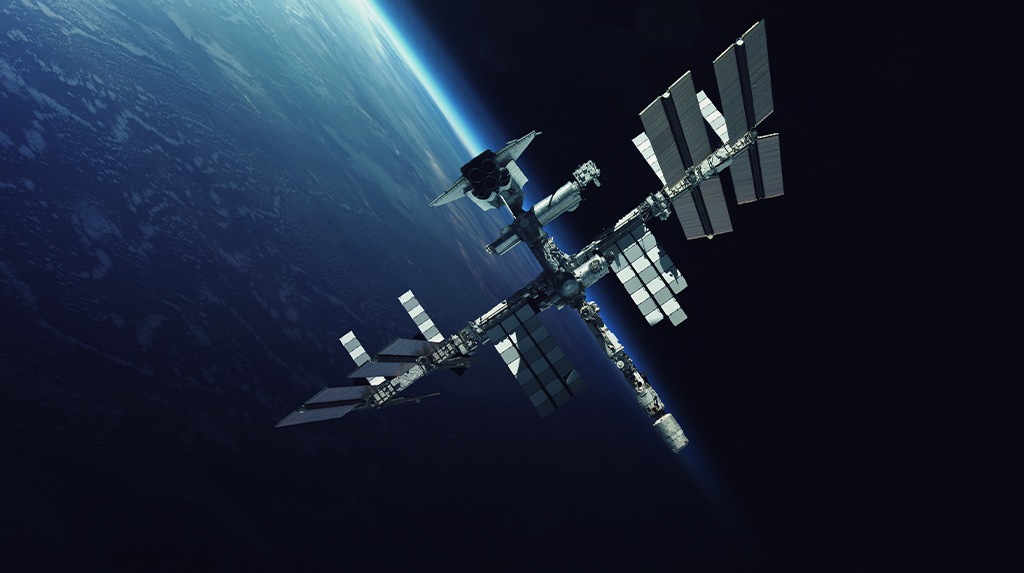
Elementary preservice teachers (PSTs) enrolled in teacher preparation programs tend to have limited opportunities to engage in the inquiry process and practice teaching science. Elementary science methods courses support PSTs with some in-class hands-on activities and opportunities to teach science content to their peers; however, many PSTs still do not feel comfortable with science content (Brígido et al. 2013). Additionally, many do not feel confident in their ability to teach it effectively as they enter their student teaching semester (Gunning and Mensah 2011). Bandura (1997) suggested enactive mastery experiences—authentic successes at dealing with a particular situation—are one of the most influential sources of self-efficacy, as they provide evidence of whether an individual can be successful as a specific task. The notion of science teaching self-efficacy has led to discussions on how best to enhance science methods courses to develop and support PSTs’ teaching self-efficacy.
Since fall 2017, PSTs in elementary science methods courses at the University of Houston-Downtown (UHD) have engaged in enactive mastery experiences through a partnership with NASA’s Office of STEM (science, technology, engineering, and mathematics) Engagement, specifically the STEM on Station team. The goals of the partnership were to:
- introduce PSTs to classroom-ready resources—lesson and activity plans that teachers can take directly from website to classroom—available from NASA,
- maintain and enhance their science skills and content knowledge, and
- develop and sustain their science teaching self-efficacy.
This article describes the accomplishments related to the ongoing partnership between science methods instructors in UHD’s Department of Urban Education and NASA’s STEM on Station program. It also examines the impact the association has had on students and how other institutions could partner with NASA.
Science teaching self-efficacy
Research has shown that self-efficacy can be a powerful predictor of performance both personally and professionally. “Self-efficacy is concerned with judgements (sic) about how well one can organize and execute courses of action required to deal with prospective situations that contain many ambiguous, unpredictable, and often stressful, elements” (Bandura 1982, pp. 200–201). Teachers with strong self-efficacy for a content area (e.g., science) will make persistent and enthusiastic efforts within those areas and are, therefore, more likely to succeed within that content area. Those with low self-efficacy will give up after minimal effort or even avoid a content area altogether (Holzberger, Philipp, and Kunter 2013; Palmer 2006).
Science self-efficacy is an issue of concern for elementary PSTs. Studies with elementary preservice and beginning teachers show that a lack of confidence in their ability to teach science negatively impacts both the quantity and quality of science instruction (Brígido et al. 2013; Gunning and Mensah 2011). In their study with beginning elementary teachers, Appleton and Kindt (1999) found that those with low science self-efficacy avoided hands-on science and used strategies based on reading and writing. Similarly, Huinker and Madison (1997) explain that “the more positive the impact on pre-service elementary teachers’ efficacy during their teacher preparation program, the more likely it is that these individuals will engage in effective teaching behaviors in the future” (p. 109).
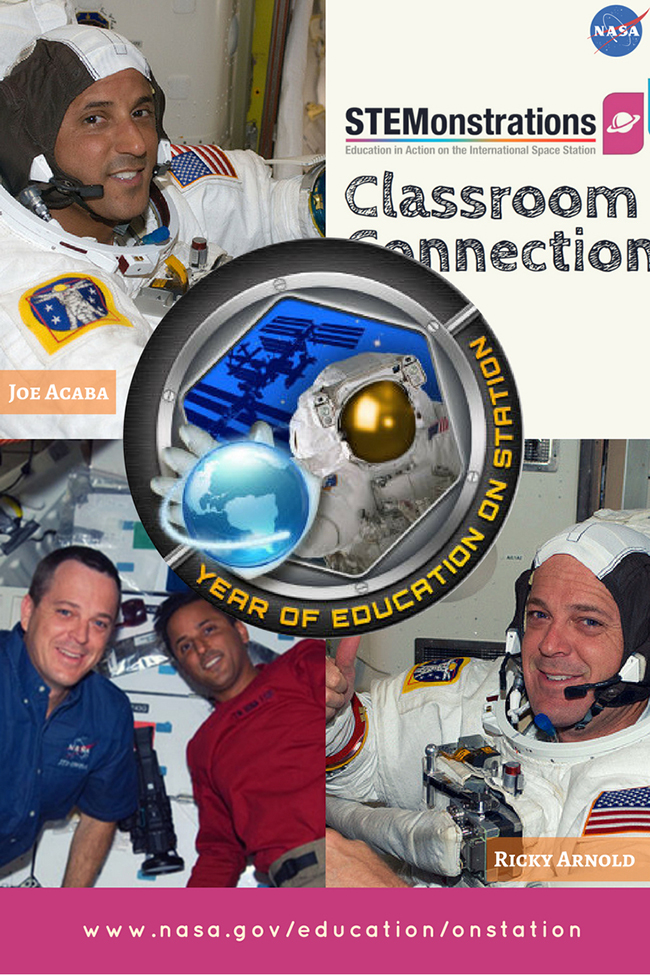
About STEM on Station
In a complex, ever-changing world, teachers need to equip students—our future leaders and explorers—to take on new challenges. To do this, students must develop the necessary STEM knowledge and skills to work through problems and come up with creative solutions. The team of STEM on Station, from NASA’s Office of STEM Engagement, does this while connecting students and educators to the International Space Station (ISS).
STEM on Station uses the ISS, its crew, and the onboard research to inspire, engage, and educate kindergarten to college students and educators. From a comprehensive website to conversations with astronauts in space to hands-on STEM activities developed through high-profile partnerships, STEM on Station is committed to advancing NASA’s and the nation’s STEM education and workforce pipelines using NASA’s missions and unique assets.
During the 2017–2018 school year, STEM on Station celebrated a Year of Education on Station (YES), which served as the backdrop for the UHD partnership. Two former educators—astronauts Joseph Acaba and Ricky Arnold—had back-to-back missions aboard the ISS. This opportunity enabled STEM on Station to establish a national presence across the education community, engage with influencers and media, and increase awareness of the ISS’s mission to help advance human spaceflight.
About the university and the department
UHD was founded in 1974 and is the second-largest university in Houston, serving the education needs of the nation’s fourth-largest city. UHD is a comprehensive four-year university with over 14,000 students. The BA in Interdisciplinary Studies of Education ranks second in the top five most popular undergraduate degree programs, and accounts for 10% of the undergraduate population. UHD is a Hispanic- and minority-serving institution with approximately 40% (1,091) of all undergraduates self-identifying as Hispanic or Latinx, and over 65% of Hispanic undergraduates identifying as female. Hispanic women are also the student demographic with the highest graduate rate (23%) (Data USA 2017; UHD 2019).
The Department of Urban Education is part of the College of Public Service. Located in downtown Houston, the department and faculty embrace their roles in preparing undergraduates to be competent elementary and secondary teachers in urban and multicultural settings, as well as leaders in Houston metropolitan school districts. The department offers preparation for both undergraduate and postbaccalaureate students seeking early childhood, elementary, and secondary core subject certification, with supplemental English as a second language or bilingual certification. The teacher preparation program includes theory, methods, and field-based courses. Additionally, students work with in-service teachers within selected public schools in several Houston metropolitan districts.
Development of the partnership
Like many opportunities, the partnership between NASA and UHD began with a group of enthusiastic individuals from both organizations and specific circumstances bringing them together. The president of UHD is lifelong friends with astronaut Joseph Acaba, who served as a flight engineer aboard the ISS for Expedition 53/54 and participated in YES from September 2017 through February 2018. Astronaut Acaba is a former secondary school math and science teacher. As such, he wanted to share his knowledge, experience, and expertise in his capacity as an educator and astronaut with PSTs at UHD.
The authors of this article and other NASA and UHD representatives met at NASA’s Johnson Space Center to determine how the partnership would look and feel. Since then, both UHD and NASA’s STEM on Station have worked to achieve three overarching goals:
- Strengthen PSTs’ science content knowledge and science teacher self-efficacy.
- Introduce PSTs to NASA’s educational resources, which are available to all teachers through the STEM on Station website.
- Through NASA’s educational resources, increase the quality and quantity of hands-on opportunities for PSTs to engage in the inquiry process.
Participating preservice teachers
Since fall 2017, 289 elementary PSTs have participated in the NASA–UHD partnership through their science methods courses. The demographics of the students enrolled in science methods align with the general demographics of the university and the teacher preparation program. Students’ NASA experiences in science methods included working with NASA educational specialists from STEM on Station, using NASA-related curriculum and resources, designing and running their own experiments, and performing hands-on NASA-related experiments and activities.
Enactive experiences in science methods
In-class engagements with education specialists
At least once per semester since the partnership began, NASA educational specialists visit science methods classes and work directly with elementary PSTs. During these visits, educational specialists engage PSTs in hands-on activities, introduce them to a variety of online resources, such as NASA’s Eyes, NASA STEMonstrations, and NASA Wavelength, through a searchable database of lesson and activity plans for teachers on the STEM on Station website.
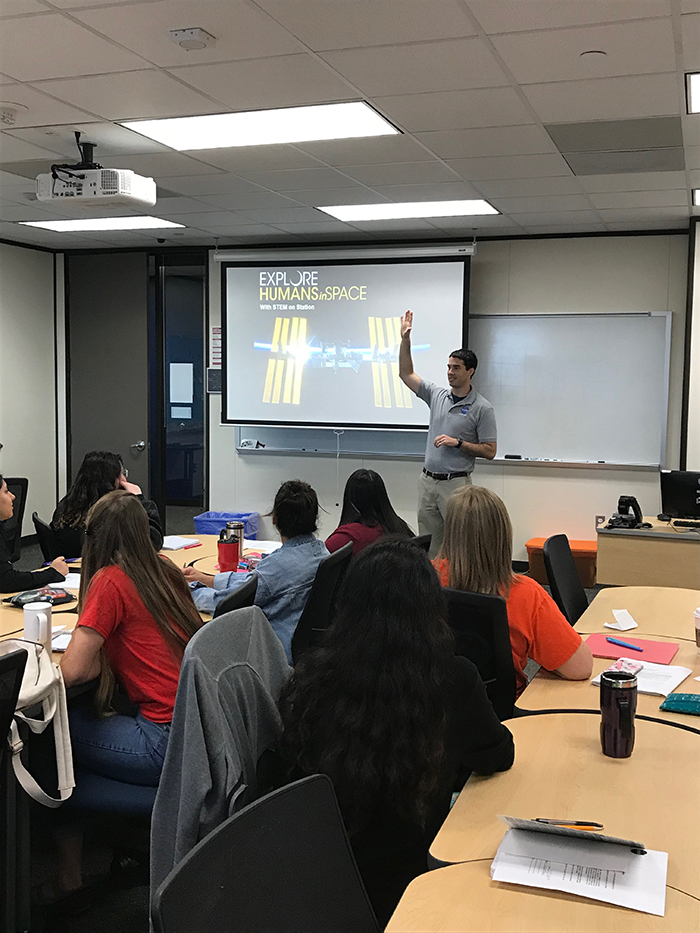
Educational specialists also take PSTs on a tour of the ISS via Google Expeditions. Google Expeditions is a free education app available for most smartphones, which allows students and teachers to explore over 1,000 virtual-reality and 100 augmented-reality tours. The ISS tour serves several purposes. First, similar to the hands-on activities, the virtual tour is a way for PSTs to have the same type of learning experience that their students can have through this technology. Secondly, it is a way to show PSTs how to integrate into their future classrooms digital technology that is generally available and relatively inexpensive for schools and teachers to access. In this respect, the educational specialists took the time to show PSTs how to use Google Expeditions. PSTs learn how to guide their students on a tour of the ISS. PSTs learned how to transition from one part of the ISS to another, point students to particular features in an ISS module, and use the available “cheat sheets” that have information and age-appropriate questions about the ISS.
Although the viewing experience is best through virtual reality goggles, students and teachers can access tours on smartphones or other devices that allow for 360° imagery. Safety warning: When using VR goggles, students should be seated as they look around the 360° immersive environment. Students should also remove the VR goggles if they become light-headed or nauseous.
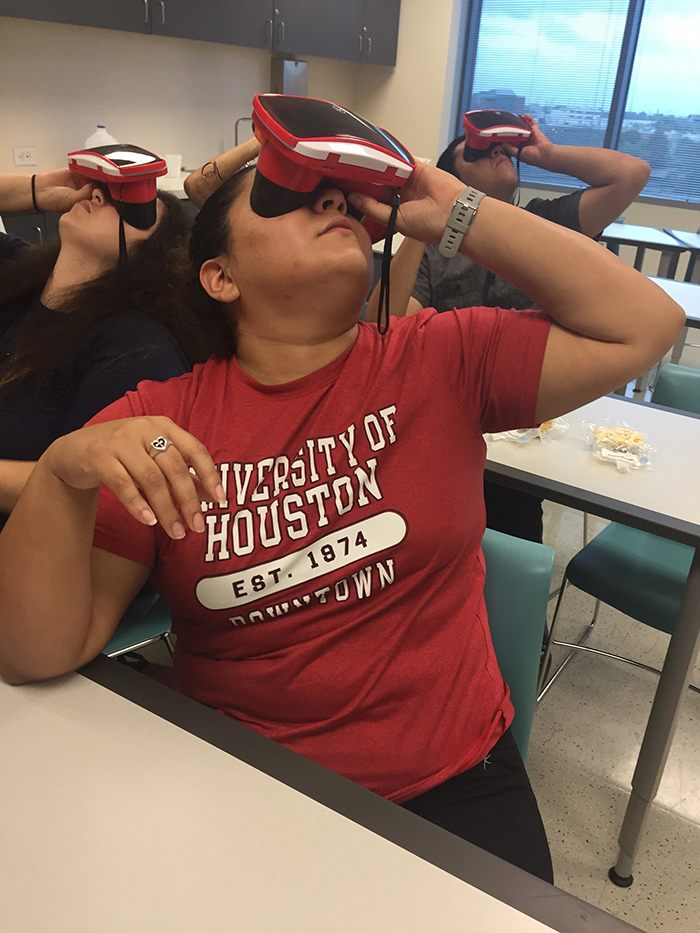
The in-class engagement is also an opportunity for NASA educational specialists to teach PSTs where and how to access online resources. These resources include showcasing NASA’s Eyes—a website and application that enable students and teachers to explore the planets, dwarf planets, moons, comets, and satellites in our solar system. As former teachers, STEM on Station educational specialists know that novice and veteran teachers alike want and need lessons/activities that are classroom-ready. Therefore, specialists make a point to show PSTs how to access NASA-related curricula (both lessons and labs). Education specialists also share NASA’s Office of STEM Engagement website, which allows visitors to find materials and opportunities through a “super search” engine. Visitors can sort by audience, grade level, opportunity, subject, and type to filter through over 1,300 resources and opportunities available.
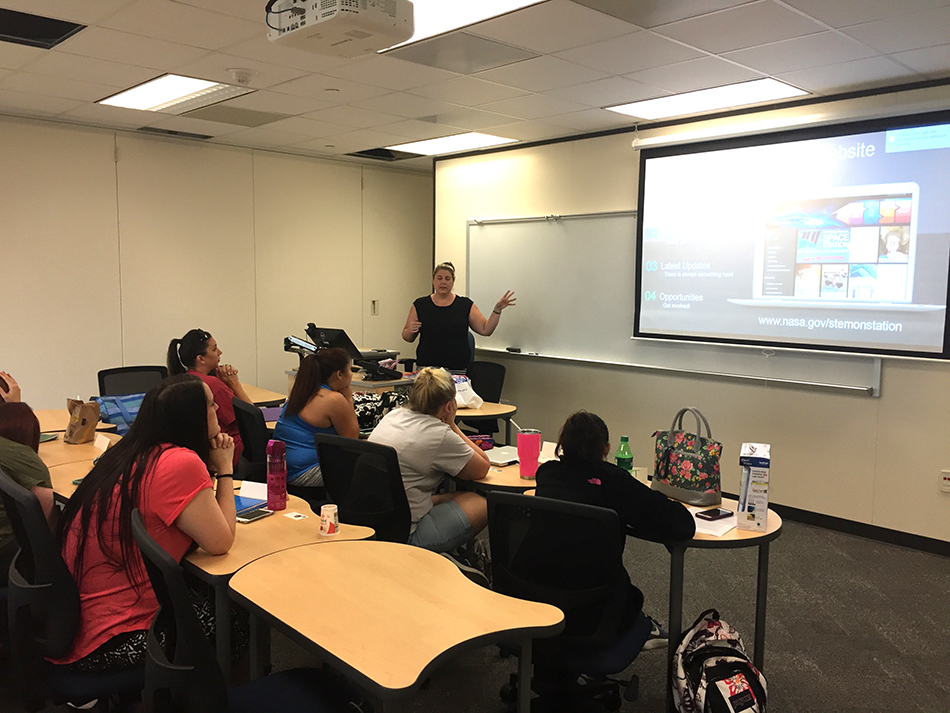
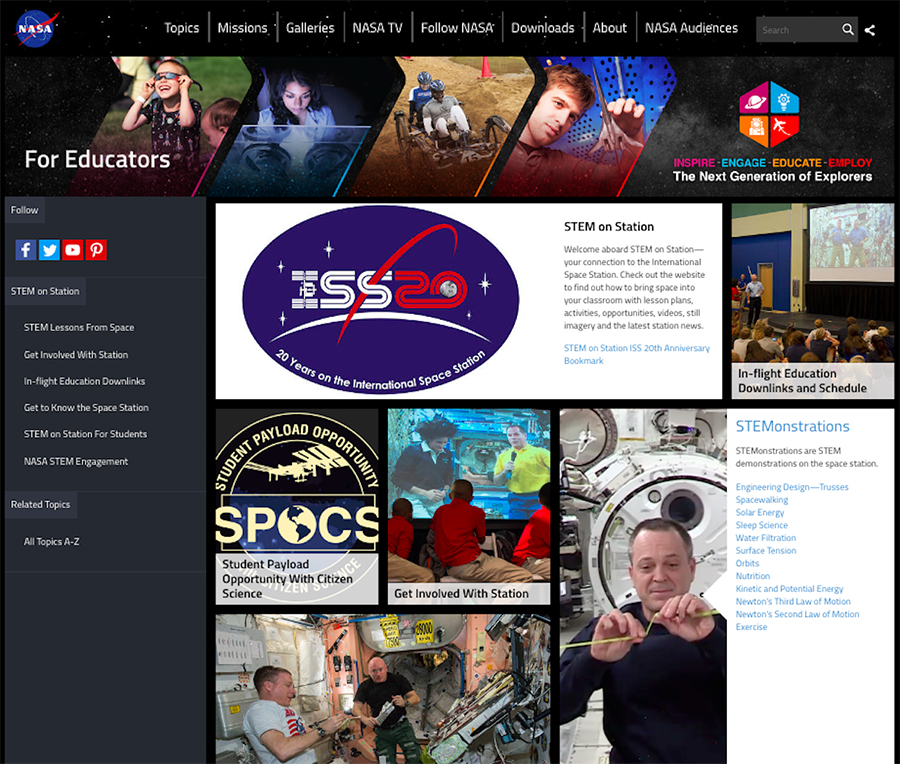
Although not all institutions have a NASA center in their backyard, all PSTs, teachers, and teacher educators can access NASA’s Office of STEM Engagement’s resources and opportunities. Additionally, organizations can connect NASA’s Educator Professional Development Collaborative (EPDC). The EPDC serves STEM educators at all levels, including K–12 teachers, PSTs, higher education faculty, and informal educators. The EPDC provides its services in-person and virtually.
NASA-generated labs and activities
Through the partnership, PSTs are introduced to a wide range of classroom-ready labs and activities developed by NASA and its partners. All of these materials are available online, free of charge, and align to Next Generation Science Standards. PSTs greatly benefit from these experiences. Anecdotally, many of the elementary PSTs have confessed to “being afraid” of teaching science because it is “complicated” and “difficult to understand.” Additionally, many of the elementary PSTs have written and spoken about negative experiences they had in science classes as students and admitted that these experiences have carried over into their professional lives.
The hands-on NASA-based activities PSTs perform in their science methods courses have served to build and reinforce their science teaching self-efficacy in multiple ways. First, the activities described in this article create positive experiences, both individually and collectively, for the PSTs through the support and interaction with science methods instructors and NASA educational specialists. Second, the activities dispell the misconception that science, especially at the elementary level, has to be complicated to be effective. Through these activities, PSTs see firsthand that good science can be done with simple materials and that relevant science content and concepts can be addressed in ways that are fun and engaging.
Mass vs. Weight: Air-Powered Mass
Newton’s laws of motion and differentiating between mass and weight are topics that can be difficult for novice teachers to address effectively. The Air-Powered Mass activity is one in a series that investigates mass versus weight, challenging students to examine Newton’s second law of motion. This activity measures how a constant force accelerates objects of different mass. This activity addresses several elementary disciplinary core ideas and crosscutting concepts outlined in A Framework for K–12 Science Education, including Forces and Motion, Systems and System Models, and the Interdependence of Science, Engineering, and Technology. During the activity, PSTs use simple equipment, such as a handheld air pump, pennies, and straws, to measure the movement of a mass car (template provided). PSTs increase or decrease the amount of mass using the pennies and propel the car using the air pump. They then collect and graph their data and compare it to the data collected by their peers as part of a group discussion on Newton’s second law of motion.
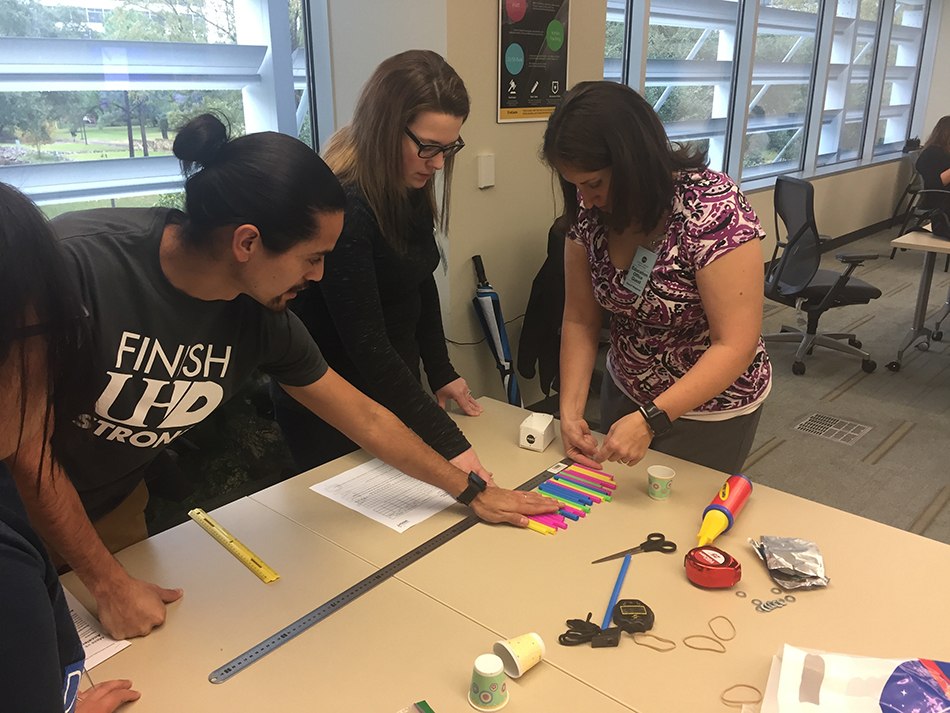
The Air-Powered Mass activity is risk-free and does not involve hazardous materials or equipment, but students and teachers should always exercise caution, wear safety goggles, and be aware of their surroundings during the activity.
In addition to students comparing data with each other, students also compare their data with a NASA STEMonstration of Newton’s second law. STEMonstrations are short videos available on NASA’s website and YouTube that feature an astronaut aboard the ISS demonstrating a scientific principle or discussing how astronauts live and work in near-Earth orbit in a microgravity environment. In the STEMonstration video, astronaut Randy Bresnik demonstrates the relationship between force, mass, and acceleration. The video provides an excellent visual for sparking conversations about the similarities and differences in Newton’s second law in “regular” gravity on Earth, versus in microgravity aboard the ISS.
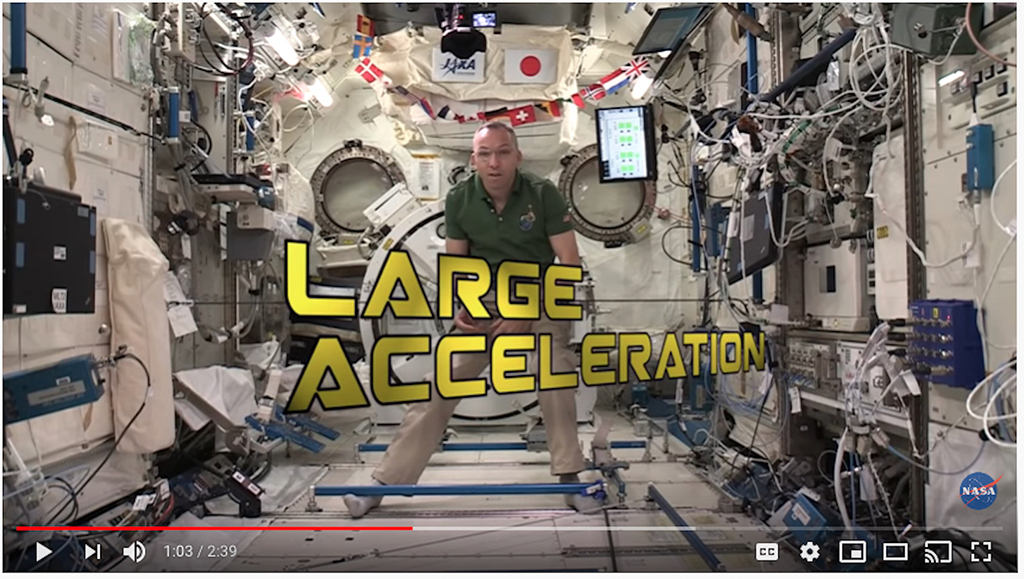
Eggstronaut Parachute Challenge
Students carefully measure and connect string from the cup, which will carry their Eggstronaut, to their parachute.
Another classroom-ready activity that challenges PSTs’ ability to work in teams toward a common goal is the Eggstronaut Parachute Challenge (EPC). NASA has different versions of EPC: Eggstronaut Elementary activity, Eggstronaut Parachute Challenge Over Easy, and On To Orion! All three versions of this activity challenge students to construct a parachute capable of slowing the descent of an egg and minimizing the impact when it lands.
PST teams are given identical materials and construct a parachute device that slows the descent of a hardboiled egg. PSTs explain the scientific principles behind their design and their rationale for construction decisions.
Safety warning: Students will be using scissors for this activity. Students and teachers should exercise caution and be aware of their surroundings during the activity. The landing area must be clear of people and teachers should prevent students from trying to catch falling parachutes. If using plastic eggs, keep students back to avoid broken pieces of plastic. Teachers should also tape together coins or washers used to add weight to the egg to prevent pieces from flying around during impact.
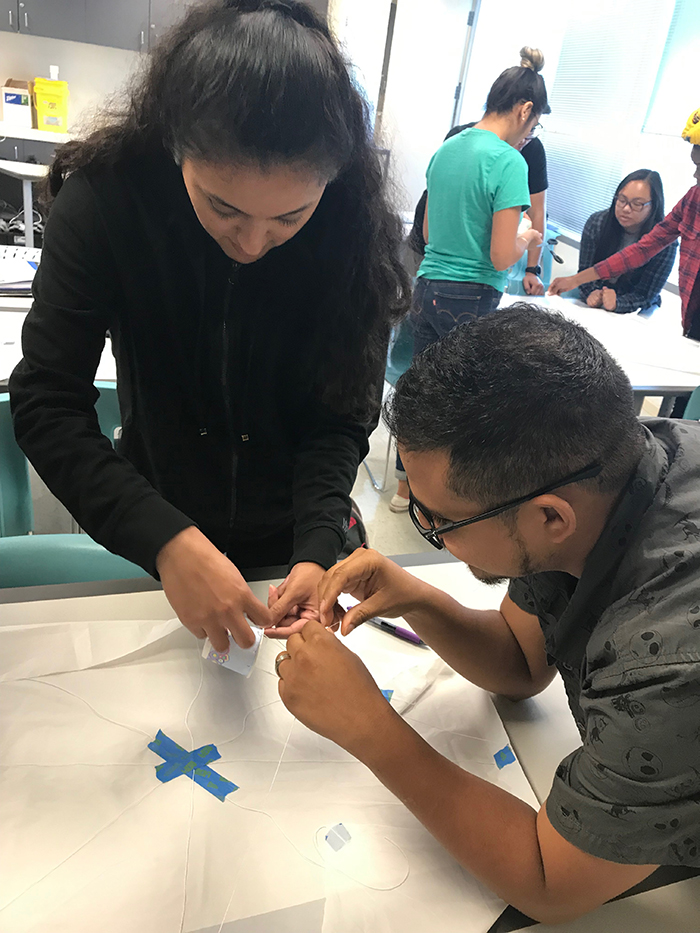
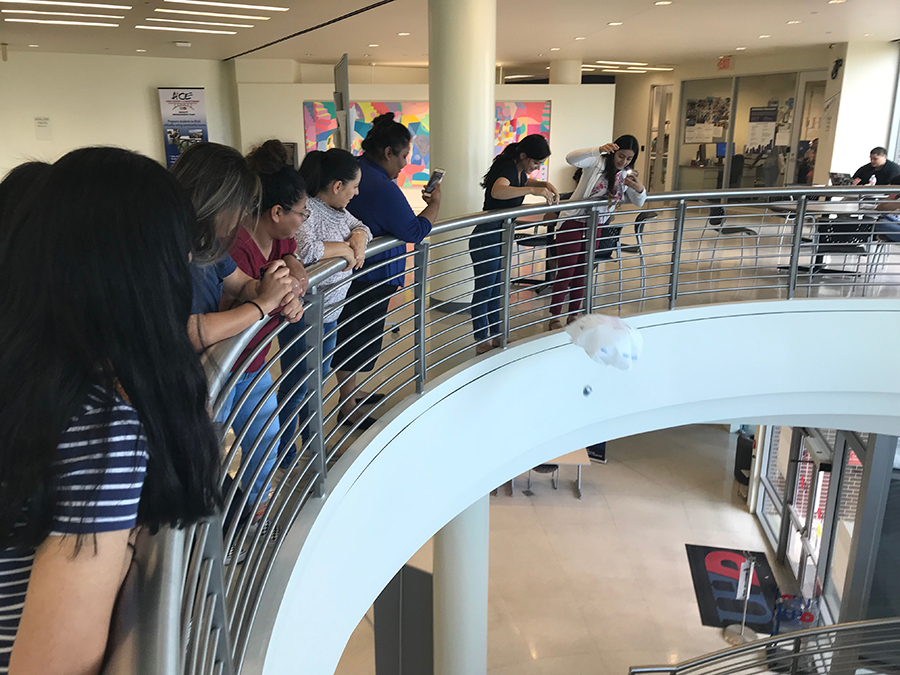
Sound on a String
A typical laboratory strategy in the elementary classroom is to have students rotate around a series of centers or stations with different exercises or activities. NASA’s Sound on a String activity has PSTs rotate through a series of activities to develop a hypothesis for how sound travels. The PSTs experiment with different types of string, sizes of string, and types and sizes of cups to determine the best method to transmit sound on a “string–cup phone.”
This activity helps elementary PSTs address physical science disciplinary core ideas of Waves and Their Applications in Technologies for Information Transfer and Forces and Interactions, as well as crosscutting concepts of Cause and Effect and Patterns. Additionally, Sound on a String uses simple materials, reinforcing that good science can be done in simple ways, yet create powerful experiences for elementary students.
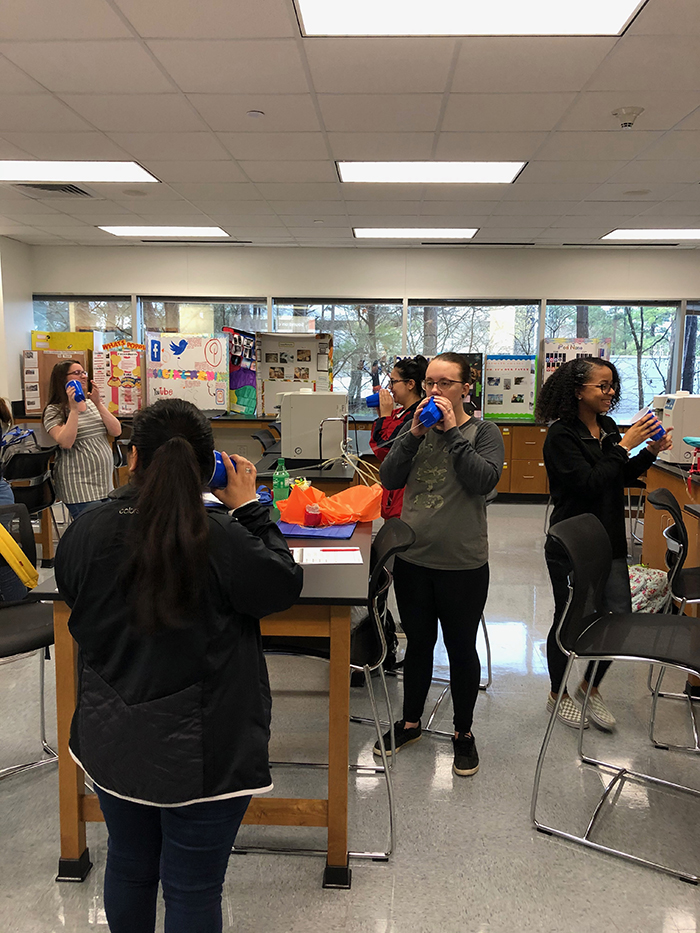
Engineering concepts can also be integrated into the activity by having older or more advanced students construct the various string–cup phones. However, for younger or less capable students, it is recommended that various string–cup phone be prepared for each station. Additionally, teachers should demonstrate the proper use of a string–cup phone (i.e., demonstrate that the string must be pulled tightly) before beginning the activity.
Student-created experiments
In addition to engaging in NASA’s classroom-ready labs and activities, PSTs gain experience in the inquiry process by designing and running their own experiments. One of the primary purposes of the ISS is conducting scientific investigations. Therefore, PSTs are challenged to create, run, refine, and rerun experiments using similar school-based resources and materials available to astronauts such as Joseph Acaba and Ricky Arnold. Materials include magnets, different-sized containers, gyroscopes, parachutes, elastic bands of various sizes and materials, metal and plastic Slinkys, and masses of different shapes, sizes, and densities. Like the astronauts aboard the ISS, students took care to follow safety rules and wear proper safety equipment throughout their experiments.
The PSTs’ science experiments are generally successful, with each group running and refining their experiment through two iterations. Success, however, is not measured in whether an experiment worked or whether their hypotheses are supported. Instead, the success comes from the students’ participation and the experience they have in the inquiry process. Experiments have included
- measuring changes in the swing of a pendulum or the oscillation of a spring using objects of different masses and densities,
- investigating the surface tension of liquids,
- testing the range of magnetic fields, and
- experimenting with Newton’s second (F = ma) and third (action/reaction) laws.
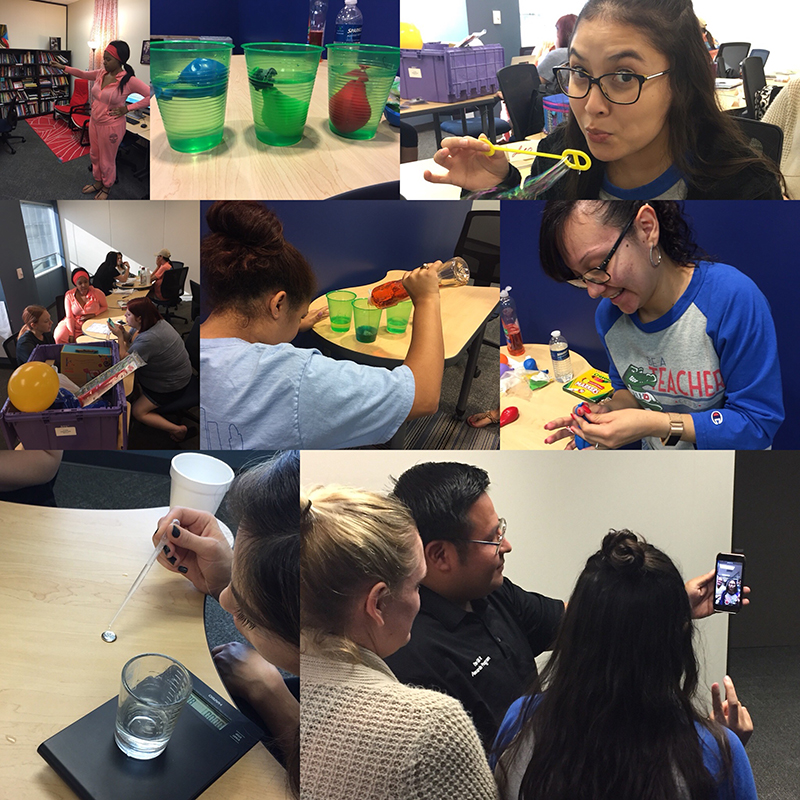
Some PSTs have found the material limitations difficult. However, many appreciate and enjoy the challenge of creating, running, and refining their experiments. Additionally, PSTs gain a new appreciation for the limitations of being on the ISS for the astronauts and their experiments.
Preservice teacher evaluations
The positive impact on the elementary PSTs’ science teaching self-efficacy, due to the in-class engagement with NASA educational specialists and hands-on activities, cannot be understated. The introduction and incorporation of NASA-generated activities into science methods allows PSTs to hone their science-related skills and content knowledge. Secondly, these activities show PSTs where to find and how to use high-quality STEM-related content in their classrooms. And finally, the PSTs experience these activities first-hand. Through their experiences, they realize that science activities can be relatively easy, fun, and engaging. Altogether, these experiences make it much more likely that PSTs will use NASA-related resources in their future classrooms.
Each semester of the partnership, students have been asked to rate their NASA-related experiences. The survey consists of closed-ended items on which students rank items using a scale of either 1 to 5 (1 = strongly disagree; 5 = strongly agree) for NASA-related statements or 1 to 4 (1 = strongly disagree; 4 = strongly agree) for science methods course–related statements. Examples of survey items include, “This NASA experience has inspired me to bring NASA content into my classroom” and “Participation in the STEM on Station program was a good investment of time in my science methods course.”
Franklin S. Allaire (allairef@uhd.edu) is assistant professor of science education in the Department of Urban Education at the University of Houston–Downtown. Becky Kamas (becky.kamas@nasa.gov) is STEM on Station activity manager in the Office of STEM Engagement at NASA Johnson Space Center in Houston, Texas.
Of the 289 students who have participated in the NASA–UHD partnership since its inception in science methods courses, 251 responded to the survey (86.8% response rate). The makeup of the student participants echoes the university’s broader student body. Forty-one percent of the participants self-identified as Hispanic/Latinx, 12% as white (non-Hispanic), and 5% as African American. An average of 69.3% of respondents plans to teach students in grades K–2.
The PSTs who responded to the voluntary surveys were overwhelmingly positive about their experiences. For example:
- Over 87% of respondents agreed or strongly agreed that participating in the STEM on Station program was a good investment of time in their science methods courses.
- 85% of respondents agreed or strongly agreed that participation in the STEM on Station program provided a focus for learning about the inquiry process.
- 91% enjoyed learning about the inquiry process through the STEM on Station program.
- 77% percent of respondents noted that their experiences with NASA inspired them to bring NASA-related content into their classrooms.
- 90% of respondents felt more confident in their ability to plan and teach science.
- 67% of respondents thought they would be more effective at teaching STEM concepts introduced in their NASA experience.
Qualitative comments from PSTs were equally positive. Elementary PSTs used the words “excited” and “engaged” to describe their experiences. One PST commented that she now felt “fired up” about teaching science and hoped that she would be placed in a science classroom for her student teaching. Another noted that she had been incredibly worried about having to teach science, but was now “relieved” because of the accessibility of the NASA resources. Other PSTs enjoyed the fact that all of the NASA educational specialists were former classroom teachers and could “speak to them from a teacher perspective.” Additionally, several PSTs noted that knowing there were other “teaching” opportunities, and they were not limited to the K–12 classroom, opened their eyes to other opportunities to use their teaching degrees and experience.
Educational Downlink
On Tuesday, February 13, 2018, UHD successfully hosted an Educational Downlink between UHD and astronaut Joe Acaba aboard the ISS. Several university departments, including the Department of Urban Education, President Muñoz’s office, the university provost, the dean of the College of Public Service, the Office of Public Relations, the Office of Event Planning, and the Office of Technology, collaborated to ensure the success of the event. The downlink was a live question-and-answer session between PSTs and Acaba.
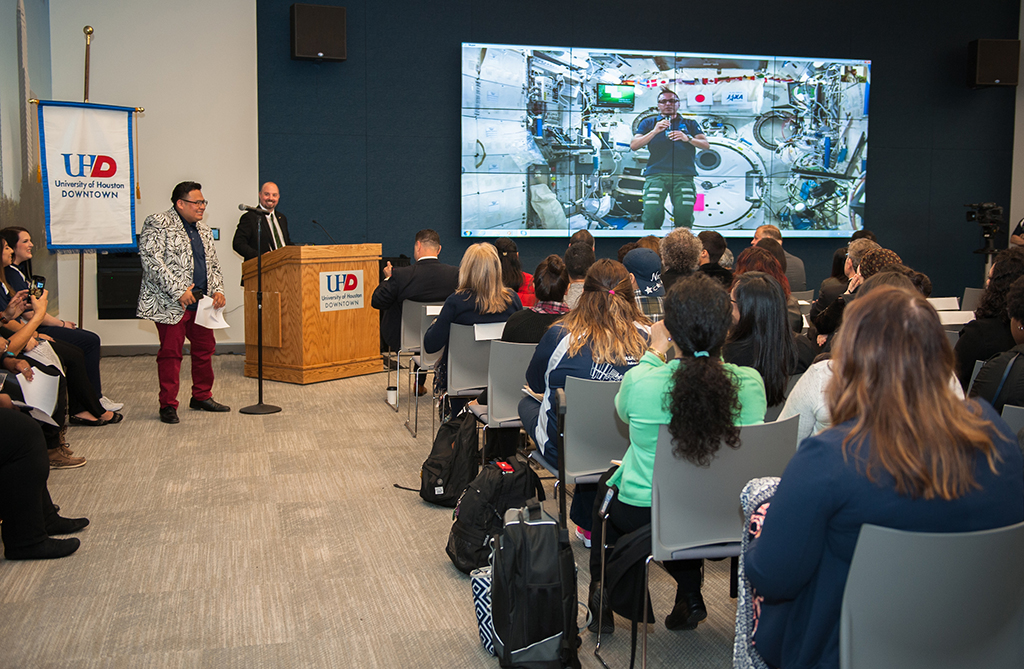
Connecting students, PSTs, and classroom teachers with STEM experts, such as astronauts, through Educational Downlinks is a way to create invaluable learning opportunities in and out of the classroom. In general, STEM-related subject matter experts can share exciting developments in various fields of study and humanize research conducted by professionals. More specifically, connecting PSTs with Acaba while he was aboard the ISS was an opportunity to learn first-hand about living and working in space, what life was like for an astronaut, and to learn how to translate the research happening aboard the ISS into their everyday lives and classrooms.
Twelve undergraduate PSTs and one graduate student, all of whom participated in STEM on Station during the fall 2017 semester in their science methods courses, asked Acaba pointed questions about teaching, science concepts and content, and life as an astronaut and aboard the ISS. PSTs’ questions included:
- “For our STEM on Station experiment, my partners and I created and ran experiments looking at the effect of different chemicals on the surface tension of water. Do chemicals, like soap or salt, impact the surface tension of liquids the same way in microgravity as they do on Earth?”
- “Many of us are preparing to be elementary school teachers. What advice would you give to teacher candidates to make science exciting and engaging for younger students?”
- “What do you and the other astronauts do for special occasions, such as birthdays, American and other country’s holidays, aboard the space station?”
Surveys regarding the Educational Downlink were also positive, with many calling it a “once-in-a-lifetime experience” and stating that they were “honored” and “inspired” by the interaction with Acaba. PSTs also commented, in a similar vein to their experiences with NASA educational specialists, that their eyes were opened to the idea that they, as teachers, could also be astronauts like Acaba and Arnold.
The PSTs developed all the questions for the Educational Downlink through their science methods courses. As noted previously, Acaba was a math and science teacher before becoming an astronaut, and the participating PSTs were all undergraduate and graduate students in the Urban Education Department. Therefore, the questions asked at the UHD Downlink were reflections of these professional experiences.
The scope and types of questions will depend on the age of the Downlink participants, the institution hosting the Downlink, and the astronaut participating in the Downlink. Downlink questions should be age-appropriate and reflect the interests of the students participating and the institution they represent.
UHD’s Downlink was attended by over 300 students, faculty, and staff, as well as several officials from Johnson Space Center, including the deputy director of Johnson Space Center’s External Relations Office and the director of the University Partnerships and Collaboration Office. The Downlink was also simultaneously broadcast on both NASA TV and UHD’s website. Additionally, the event was publicized by various organizations, including the University of Houston and Houston’s NBC-affiliated station, KPRC. The Downlink, in its entirety, is available on YouTube.
The long-term impact of the NASA–UHD partnership
Certainly, UHD’s PSTs and instructors benefit from their proximity to Space Center Houston and Johnson Space Center. As a result of the NASA–UHD partnership, PSTs have gained invaluable experiences with NASA and STEM professionals. PSTs, who have since graduated, have reported back that they continue to use their NASA-related experiences and resources in their classrooms. This includes, but is not limited to, inviting NASA educational specialists to their schools, using downloadable lesson and activity plans, and integrating NASA-like scenarios into inquiry and design-thinking challenges. Several former PSTs have noted the resources they were introduced to through this partnership were especially significant in supporting their science teaching during the critical first years of their teaching careers.
Franklin S. Allaire (allairef@uhd.edu) is assistant professor of science education in the Department of Urban Education at the University of Houston-Downtown. Becky Kamas (becky.kamas@nasa.gov) is STEM on Station activity manager in the Office of STEM Engagement at NASA Johnson Space Center in Houston, Texas.
Inquiry STEM Teaching Strategies Informal Education


